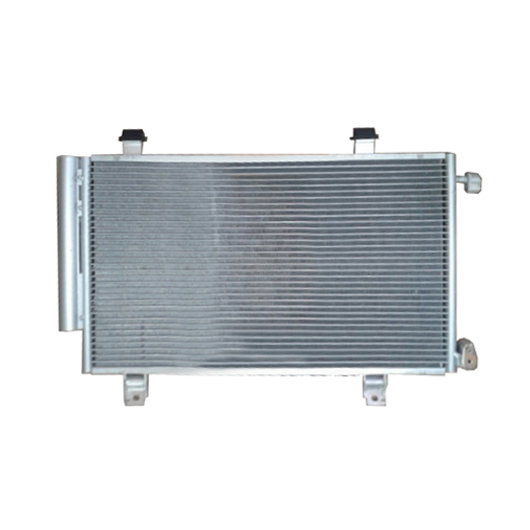Features of Automotive Condensers
2024-06-12
An automotive condenser is a key component of a vehicle's air conditioning (A/C) system, playing a vital role in the cooling and condensation process of refrigerant gases. Here's an overview of its function, features, and importance:
Function:
1. Heat Exchange:
- The primary function of the automotive condenser is to dissipate heat from the A/C system by transferring heat energy from the refrigerant gas to the surrounding air, thereby cooling and condensing the gas into a liquid state.
2. Condensation:
- As high-pressure, high-temperature refrigerant gas flows through the condenser coils, ambient air passes over the coils, causing the gas to release heat and condense into a high-pressure liquid.
3. Pressure Reduction:
- The condensed refrigerant liquid then flows to the expansion valve or orifice tube, where its pressure is reduced, allowing it to evaporate and absorb heat from the vehicle's interior, cooling the air circulated by the A/C system.
Features:
1. Construction:
- Automotive condensers are typically constructed from aluminum or copper tubes with aluminum fins, which provide excellent heat transfer properties, corrosion resistance, and durability in automotive applications.
2. Design:
- Condensers are designed to maximize surface area for efficient heat exchange, with a compact and lightweight design that fits within the vehicle's engine compartment.
3. Fin Design:
- The fins on the condenser tubes increase the surface area available for heat transfer, enhancing the cooling efficiency of the condenser and improving overall A/C system performance.
4. Mounting Brackets:
- Some automotive condensers come with integrated mounting brackets or hardware for easy installation and secure attachment to the vehicle's chassis or radiator support.
5. Refrigerant Connections:
- Condensers feature inlet and outlet ports for connecting refrigerant lines, typically located at the top or bottom of the condenser assembly for easy integration into the A/C system.
6. Fittings and Seals:
- Automotive condensers may include fittings, O-rings, and seals to ensure leak-free connections and proper sealing of refrigerant lines, preventing refrigerant leaks and system inefficiencies.
Importance:
1. Cooling Performance:
- The automotive condenser plays a crucial role in maintaining comfortable interior temperatures by dissipating heat from the A/C system, allowing for efficient cooling of the air circulated inside the vehicle cabin.
2. A/C System Efficiency:
- A properly functioning condenser is essential for the overall efficiency and performance of the vehicle's A/C system, ensuring effective heat transfer and refrigerant condensation to support reliable cooling operation.
3. Driver Comfort:
- A malfunctioning or inefficient condenser can lead to reduced cooling capacity, longer A/C system cycling times, and decreased driver comfort, especially in hot weather conditions or during long drives.
4. Component Protection:
- The condenser also helps protect other A/C system components, such as the compressor, evaporator, and expansion valve, by maintaining optimal operating temperatures and pressures within the system.
5. Safety:
- Proper A/C system operation, facilitated by a functioning condenser, can improve driver alertness, reduce fatigue, and enhance overall safety by ensuring a comfortable and distraction-free driving environment.
Maintenance and Care:
1. Regular Inspection:
- Inspect the condenser for signs of damage, corrosion, or debris buildup, especially in areas prone to road debris, insects, or environmental contaminants.
2. Cleaning:
- Periodically clean the condenser coils using compressed air, a soft brush, or a gentle stream of water to remove dirt, dust, leaves, and other debris that may obstruct airflow and reduce cooling efficiency.
3. Refrigerant Leak Checks:
- Conduct regular inspections for refrigerant leaks at the condenser fittings, connections, and seals, and repair any leaks promptly to prevent loss of refrigerant and A/C system inefficiencies.
4. Professional Service:
- If the A/C system is not cooling adequately or is exhibiting signs of malfunction, have the system inspected and serviced by a qualified automotive technician to diagnose and address any issues with the condenser or other A/C components.
Conclusion:
The automotive condenser is a critical component of the vehicle's air conditioning system, responsible for dissipating heat and condensing refrigerant gases to support efficient cooling of the vehicle cabin. By understanding its function, features, and importance, vehicle owners can appreciate the role of the condenser in maintaining comfortable driving conditions and ensure proper maintenance and care to maximize A/C system performance and longevity.



